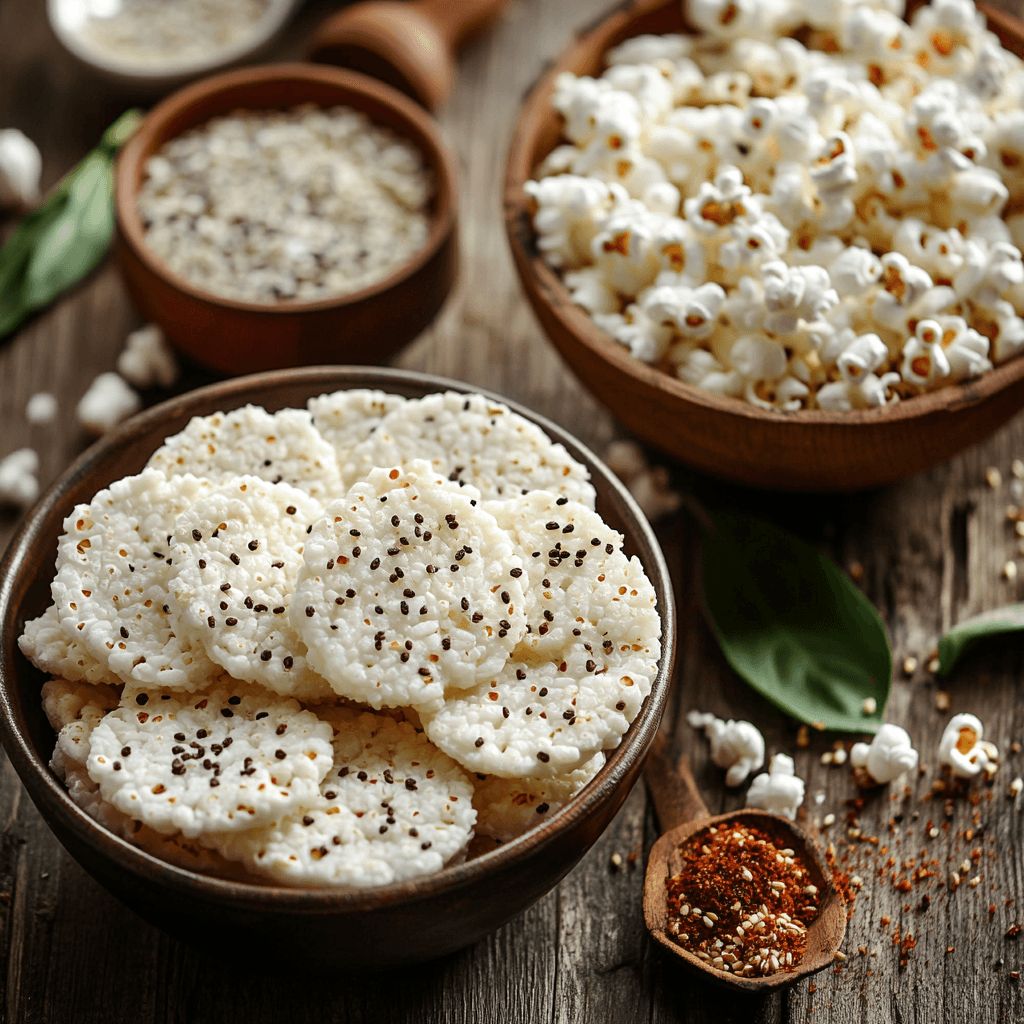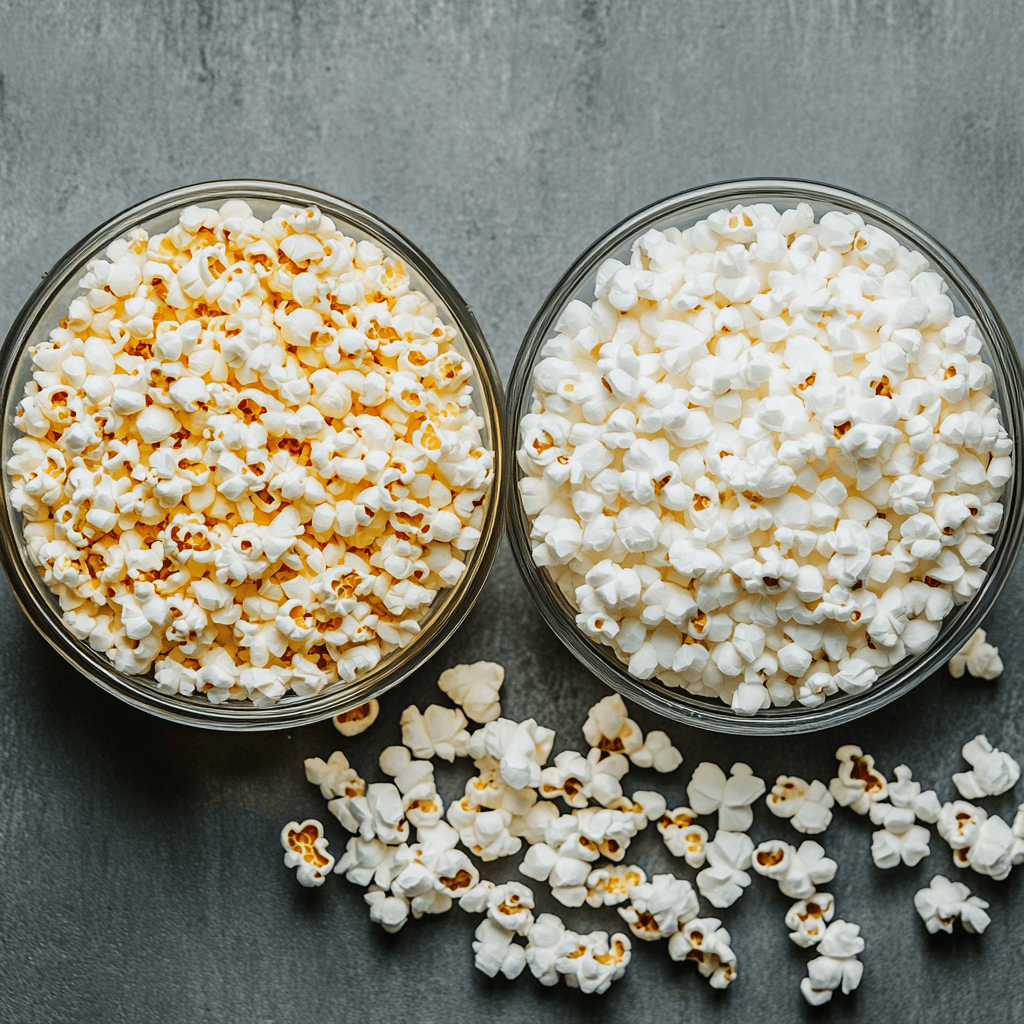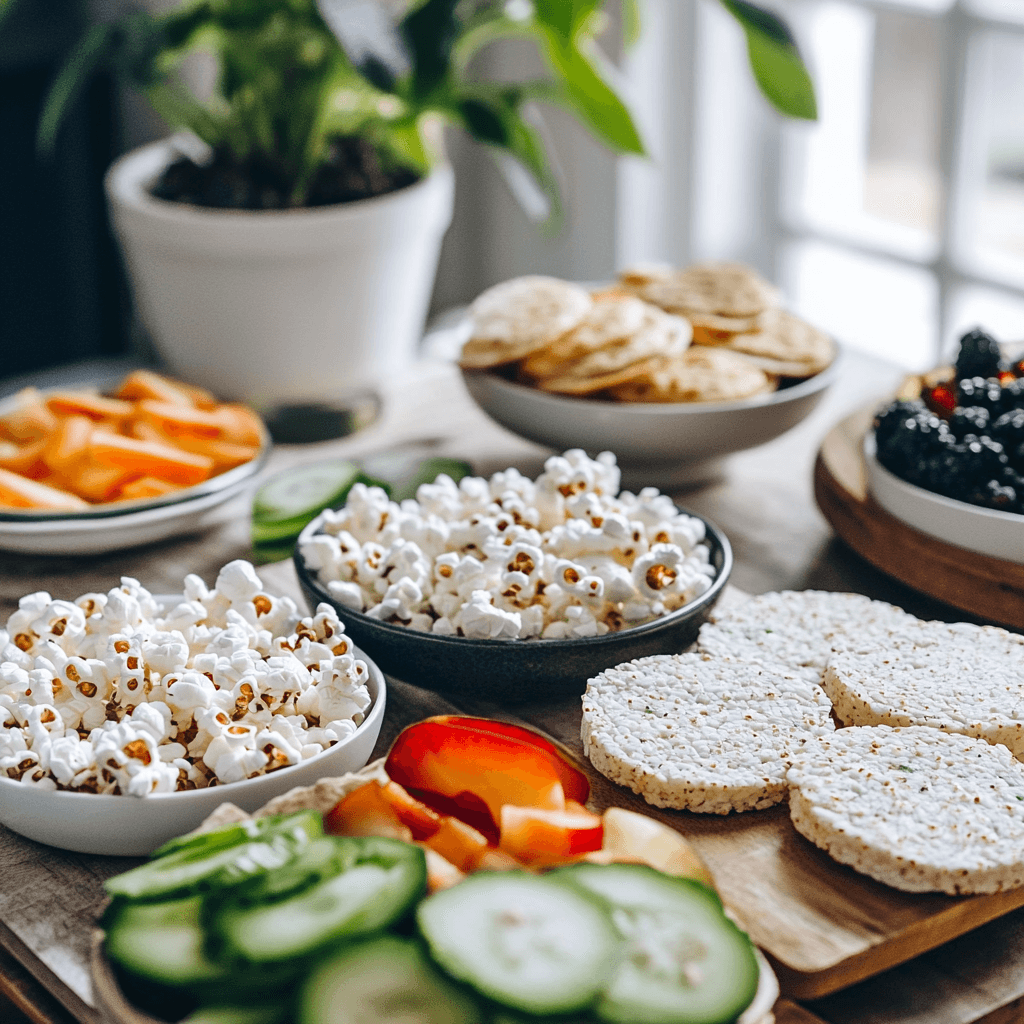
When it comes to choosing a healthy snack, rice cakes and popcorn often come up as two of the most popular options. Both are low in calories, convenient, and widely available, making them go-to choices for people looking to maintain a balanced diet. But which one is the better option? Are rice cakes better than popcorn, or does popcorn have the upper hand in terms of nutrition, taste, and health benefits?
In this article, we’ll dive deep into the comparison between rice cakes and popcorn by analyzing their nutritional value, health benefits, weight loss effects, and more. Whether you’re aiming for a healthier lifestyle, managing your calorie intake, or just curious about which snack is the better choice, this guide will help you make an informed decision.
Table of Contents
Nutritional Comparison of Rice Cakes and Popcorn

When evaluating whether rice cakes or popcorn is the better snack, it’s crucial to compare their nutritional content. Both snacks offer unique benefits, but their impact on your health depends on factors like calorie count, macronutrients, and fiber content.
Nutrient Absorption and Digestive Impact
While rice cakes are easy to digest due to their simple composition, they may not provide long-lasting energy due to their low fiber and protein levels. Popcorn, being a whole grain, aids in promoting healthy digestion thanks to its fiber content. However, individuals with digestive sensitivities may find the hulls in popcorn irritating. Choosing lightly processed options for both snacks ensures better nutrient retention and absorption.
Calorie Content
One of the primary reasons people choose rice cakes and popcorn is their low-calorie profile.
- Rice Cakes: A single rice cake (about 9 grams) contains around 35-40 calories. It’s a simple, portion-controlled snack.
- Popcorn: Air-popped popcorn contains about 30 calories per cup, making it slightly lower in calories per serving than rice cakes.
Carbohydrates and Fiber
- Rice Cakes: Rice cakes are high in carbohydrates but typically low in fiber, which means they may not keep you feeling full for long.
- Popcorn: Popcorn, especially air-popped, is high in fiber, with about 1 gram of fiber per cup. This can aid digestion and provide a feeling of satiety.
Protein Content
While both snacks provide minimal protein, pairing them with protein-rich accompaniments can make them more balanced. For instance, adding hummus, nut butter, or a slice of smoked salmon to rice cakes can boost their protein content. Similarly, tossing popcorn with nutritional yeast or serving it alongside a handful of roasted chickpeas can elevate its nutritional value.
Neither rice cakes nor popcorn is particularly high in protein. However:
- Rice Cakes: Contain about 1 gram of protein per cake.
- Popcorn: Has around 1 gram of protein per cup.
Vitamins and Minerals
Popcorn has an edge here due to its whole-grain nature:
- Rice Cakes: Offer minimal vitamins and minerals unless fortified.
- Popcorn: Contains small amounts of magnesium, phosphorus, and potassium, essential for overall health.
Health Benefits of Rice Cakes
Rice cakes have gained popularity as a diet-friendly snack due to their low calorie content and simplicity. Let’s explore some of the key health benefits of rice cakes and why they might be a good choice for certain individuals.
Low-Calorie Option for Weight Management
One of the main reasons people choose rice cakes is because they are naturally low in calories. A single plain rice cake contains around 35-60 calories, depending on the size and brand. This makes them a great option for those trying to reduce their overall calorie intake while still enjoying a crunchy snack.
Additionally, because they are light and airy, they can be paired with healthy toppings like avocado, nut butter, or hummus to create a more satisfying snack without significantly increasing calorie intake.
Gluten-Free Option
Rice cakes are inherently gluten-free, making them suitable for individuals with gluten sensitivities or celiac disease.
Simple Ingredients
Rice cakes are often made from just puffed rice and salt, making them a minimally processed snack.
Low Fat and Sugar
Most rice cakes contain little to no fat or sugar, making them a heart-healthy choice.
Versatile and Customizable
Rice cakes are incredibly versatile and can be enjoyed in both sweet and savory forms. They pair well with a variety of toppings, such as:
- Sweet Options: Peanut butter and banana, yogurt and berries, honey and cinnamon
- Savory Options: Avocado and egg, hummus and cucumber, tuna salad
This versatility makes them a convenient base for a balanced snack or light meal.
Potential Downsides of Rice Cakes
While rice cakes have several benefits, they also come with some drawbacks:
- High Glycemic Index (GI): Rice cakes can cause a rapid spike in blood sugar, leading to quick energy crashes.
- Low in Fiber: Compared to whole grain snacks like popcorn, rice cakes contain minimal fiber, making them less filling.
- Lack of Essential Nutrients: Unless fortified, rice cakes provide little in the way of vitamins and minerals.
Overall, rice cakes can be a good snack choice for those watching their calorie intake or avoiding gluten, but they may not be the most satisfying option for long-term satiety.
Health Benefits of Popcorn

Popcorn is often considered a healthier alternative to processed snacks, and for good reason. As a whole grain, it offers a variety of nutritional benefits that make it a great option for people looking for a satisfying yet healthy snack. Let’s explore why popcorn might be a better choice than rice cakes in certain situations.
Aiding Weight Loss
Popcorn’s low-calorie density and high fiber content make it ideal for weight loss. Unlike rice cakes, popcorn fills a larger volume per serving, allowing you to eat more without consuming excessive calories. Studies have shown that whole grains like popcorn help regulate appetite and improve metabolic health, making it a more satisfying snack option. Opting for air-popped varieties without butter or heavy seasonings keeps it within healthy limits.
High in Fiber for Better Digestion
One of the biggest advantages of popcorn over rice cakes is its high fiber content. Air-popped popcorn contains about 3.6 grams of fiber per ounce, making it significantly more filling than rice cakes, which have less than 1 gram of fiber per serving.
Benefits of fiber in popcorn:
- Improves digestion by promoting healthy bowel movements
- Helps control blood sugar levels by slowing down carbohydrate absorption
- Increases satiety, making you feel full longer
This makes popcorn a more satisfying snack, especially for those who struggle with frequent hunger or cravings.
Whole Grain and Rich in Antioxidants
Unlike rice cakes, which are often made from refined white rice, popcorn is a whole grain. This means it retains essential nutrients such as:
- Magnesium – Supports muscle and nerve function
- Phosphorus – Important for strong bones and teeth
- Polyphenols (antioxidants) – Help fight inflammation and oxidative stress
Studies have shown that popcorn contains more antioxidants than many fruits and vegetables, making it a powerhouse snack for those looking to boost their intake of disease-fighting compounds.
Low-Calorie When Air-Popped
If prepared correctly, air-popped popcorn is one of the lowest-calorie snacks available. A one-cup serving contains only 30-35 calories, making it even lower in calories than rice cakes.
However, buttered or pre-packaged microwave popcorn can contain unhealthy additives, excess salt, and artificial flavors, significantly increasing the calorie and fat content. For a truly healthy option, it’s best to choose air-popped popcorn and season it lightly with natural ingredients.
Helps with Weight Management
Due to its high fiber content and low calorie density, popcorn is an excellent choice for those looking to lose or maintain weight. Studies have shown that eating high-fiber foods like popcorn can help reduce overall calorie intake by making people feel fuller for longer.
Popcorn’s low energy density (fewer calories per gram of food) allows you to eat a larger portion compared to rice cakes, making it a more satisfying snack for those trying to control hunger while managing their weight.
Potential Downsides of Popcorn
While popcorn offers several benefits, there are a few things to keep in mind:
- Can be unhealthy when prepared with butter, oil, or artificial flavors – Many store-bought or microwave popcorn brands contain trans fats and excessive sodium.
- Harder to digest for some individuals – Popcorn’s fiber content can cause bloating or digestive discomfort in people with sensitive stomachs.
- Risk of choking or getting kernels stuck in teeth – Popcorn husks can be an issue for young children or people with dental problems.
Bottom Line
Popcorn is a nutrient-rich, whole-grain snack that provides more fiber, protein, and antioxidants compared to rice cakes. When prepared healthily, it is a better choice for satisfying hunger and supporting digestion. However, to maximize its health benefits, it’s best to stick to air-popped popcorn without unhealthy additives.
Taste and Texture: Rice Cakes vs. Popcorn

Sensory Experience
When it comes to sensory appeal, both snacks cater to different preferences. Rice cakes provide a stable crunch that remains consistent with each bite, making them less messy but predictable in texture. Popcorn, on the other hand, delivers a multi-sensory experience, with its light crunch followed by a chewy finish. The aroma of freshly popped corn adds to its allure, which is why it’s a favorite at cinemas and home movie nights.
Flavor Profiles
- Rice Cakes: Often described as bland or neutral, rice cakes are a blank canvas for toppings. From peanut butter and banana slices to avocado and chili flakes, their mild flavor works with both sweet and savory additions.
- Popcorn: Popcorn naturally has a nutty and slightly sweet flavor. It can be enjoyed plain or with a variety of seasonings, such as butter, cheese, caramel, or nutritional yeast.
Texture Preferences
- Rice Cakes: Offer a crisp and crunchy texture that stays consistent. They’re less likely to leave crumbs, making them less messy.
- Popcorn: Light and airy, popcorn has a unique chewiness combined with a satisfying crunch. However, it can leave hulls stuck in your teeth, which some find inconvenient.
Customization Potential
For those who love sweet treats, both snacks can serve as healthy dessert alternatives. Drizzling dark chocolate over rice cakes or sprinkling popcorn with a dash of cinnamon and stevia can satisfy sugar cravings without derailing your diet. Experimenting with herbs, spices, and even a touch of honey can make these snacks feel indulgent yet nutritious.
Both snacks are versatile, but:
- Rice Cakes: Require toppings to enhance flavor, which may increase calories and preparation time.
- Popcorn: Can be seasoned instantly, whether it’s a sprinkle of salt, cinnamon, or a drizzle of olive oil.
Convenience and Practicality
Portability
- Rice Cakes: Highly portable and come in individually wrapped packs, making them an excellent choice for on-the-go snacking.
- Popcorn: Although portable, popcorn needs to be pre-popped or purchased ready-made, which may not be as convenient as rice cakes.
Storage and Travel Tips
For frequent travelers or busy individuals, single-serving packs of rice cakes are convenient to toss into a bag without worrying about spoilage. Popcorn, while portable, requires careful packaging to prevent crumbling. Silicone resealable bags or compact containers are great for keeping popcorn fresh and uncrushed during commutes or trips.
Preparation Time
- Rice Cakes: Ready to eat straight out of the package, rice cakes are a no-prep snack.
- Popcorn: Air-popping popcorn takes a few minutes, and microwave or stovetop versions require slightly more effort. However, pre-packaged popcorn can save time.
Budget-Friendly Options
Both rice cakes and popcorn are cost-effective snack choices. A pack of rice cakes can serve multiple portions and requires no preparation, making it an affordable pantry staple. Popcorn kernels are even more economical, as a small bag of kernels can yield multiple servings when air-popped. However, pre-packaged flavored popcorn tends to be more expensive than plain options. For those on a tight budget, bulk buying popcorn kernels or plain rice cakes ensures maximum savings without compromising on snack quality.
Shelf Life
In terms of storage, rice cakes are best kept in sealed containers to maintain their crunchiness, while popcorn should be stored in airtight bags or jars to avoid staleness. Pre-popped popcorn options with resealable packaging are becoming increasingly common, offering a convenient way to enjoy fresh popcorn anytime without the hassle of preparation.
- Rice Cakes: Tend to have a longer shelf life if stored properly in a sealed container.
- Popcorn: While unpopped kernels last a long time, popped popcorn can go stale quickly unless stored in an airtight container.
Potential Drawbacks of Each Snack
Downsides of Rice Cakes
- Low Nutritional Density: Despite being low in calories, rice cakes lack substantial nutrients, such as fiber and protein.
- High Glycemic Index (GI): Rice cakes can cause blood sugar spikes, which may not be ideal for individuals managing diabetes.
Sustainability and Environmental Impact
The production of rice cakes can be more resource-intensive compared to popcorn, as it involves additional processing steps like puffing and shaping. Popcorn, on the other hand, is less processed and requires fewer resources, making it a more sustainable choice. Opting for locally sourced popcorn further reduces its environmental footprint.
Downsides of Popcorn
Popcorn also has a tendency to absorb moisture from the air, making it less appealing if not consumed quickly. To combat this, opt for single-serving bags or freshly pop a small batch to avoid leftovers going stale. Additionally, those with digestive sensitivities may find popcorn’s fiber content challenging, leading to bloating or discomfort.
- Added Ingredients: Flavored popcorn often contains added sugars, fats, or artificial seasonings, which can diminish its health benefits.
- Dental Concerns: Popcorn kernels can get lodged between teeth, leading to discomfort and potential dental issues.
Choosing the Right Snack for Your Needs
Weight Loss Goals
If you’re focused on weight management:
- Opt for popcorn due to its higher fiber content and lower glycemic impact.
- Rice cakes can also be suitable, but they may not keep you feeling as full for as long.
Dietary Restrictions
- For gluten-free diets, rice cakes are the clear winner.
- If you need more whole grains in your diet, popcorn is an excellent choice.
Lifestyle and Preferences
- If you prioritize convenience, rice cakes are easier to grab and eat without preparation.
- If you enjoy experimenting with flavors, popcorn offers endless customization possibilities.

FAQs between rice cakes and popcorn
Are rice cakes or popcorn better for weight loss?
Popcorn is often better for weight loss because of its higher fiber content, which promotes fullness. However, rice cakes can still fit into a calorie-controlled diet if portion sizes are managed.
Is popcorn a better source of nutrients than rice cakes?
Yes, popcorn provides more fiber, antioxidants, and essential minerals than rice cakes, making it a more nutrient-dense snack.
How do flavored versions affect the healthiness of these snacks?
Flavored versions of both rice cakes and popcorn often contain added sugar, salt, or fats that can reduce their health benefits. Caramel-coated popcorn or chocolate-dipped rice cakes, for example, can significantly increase calorie and sugar content, making them less suitable for weight-loss or heart-healthy diets. If you crave flavor, consider DIY options like sprinkling cinnamon on plain popcorn or spreading almond butter on rice cakes to control ingredients while keeping the snack nutritious.
Are rice cakes or popcorn better for blood sugar management?
Popcorn is better for blood sugar management due to its lower glycemic index compared to rice cakes, which can cause blood sugar spikes.
Can I eat rice cakes and popcorn together?
Certainly! Combining rice cakes and popcorn can create a fun, textured mix. Add some low-calorie seasonings for a flavorful snack combination.
Are flavored rice cakes or popcorn healthy?
Flavored versions of both snacks can contain added sugars, fats, or artificial ingredients. Opt for minimally flavored or plain varieties for a healthier choice.
Can rice cakes or popcorn fit into a keto diet?
Rice cakes are generally not suitable for a ketogenic diet due to their high carbohydrate content. However, small portions of air-popped popcorn (in moderation) may fit into some low-carb plans, as it’s less carb-dense when compared to processed snacks.
Which snack is more environmentally friendly?
Popcorn is generally considered more sustainable because it’s a whole grain that requires minimal processing, unlike rice cakes, which often involve more energy-intensive manufacturing.
Would you like to proceed with the conclusion and other sections?
Conclusion between rice cakes and popcorn
When deciding between rice cakes and popcorn, the “better” choice depends on your individual preferences, health goals, and lifestyle needs. Popcorn emerges as the more nutrient-dense option with its whole-grain benefits, high fiber content, and versatility in flavoring. It is ideal for those looking for a filling, low-calorie snack that also offers antioxidants and essential minerals.
On the other hand, rice cakes are a convenient, gluten-free snack with a long shelf life and adaptability to a variety of toppings. They’re excellent for on-the-go eating or as a light, low-fat base for creative snacking ideas.
For weight loss, popcorn’s fiber content may help you stay full longer, while rice cakes can still fit into a calorie-controlled diet if paired with nutritious toppings like avocado or almond butter. If you’re managing blood sugar, popcorn’s lower glycemic impact makes it the better choice.
Ultimately, incorporating both snacks into your diet in a balanced way can keep your snacking routine enjoyable and varied. Choose popcorn for movie nights or when you want a light and airy treat, and opt for rice cakes as a portable snack or a base for nutrient-packed spreads.
While popcorn often stands out as the more nutrient-dense option due to its fiber, whole-grain content, and filling nature, rice cakes excel in simplicity and portability. Ultimately, the best choice depends on your lifestyle. If you’re seeking a quick, no-prep snack for on-the-go situations, rice cakes might suit you better. For those who prefer a customizable, nutrient-rich snack to enjoy at home, popcorn is the clear winner. Remember, the key to healthy snacking is moderation and balance. By incorporating both into your diet thoughtfully, you can enjoy the best of both worlds.
Print
Are Rice Cakes Better Than Popcorn? A Comprehensive Comparison
Description
When it comes to healthy snacking, rice cakes and popcorn are two popular choices. Both are low in calories, easy to prepare, and can be customized with various flavors. But which one is better for you? Let’s break it down by nutrition, taste, convenience, and overall health benefits.
Instructions
Nutrition Comparison
| Nutrient | Rice Cakes (1 plain cake) | Popcorn (1 cup air-popped) |
|---|---|---|
| Calories | ~35-50 kcal | ~30 kcal |
| Carbohydrates | ~7-10g | ~6g |
| Fiber | ~0.3g | ~1.2g |
| Protein | ~0.8g | ~1g |
| Fat | ~0g | ~0.3g |
- Calories: Both are low-calorie snacks, but popcorn generally has fewer calories per serving.
- Carbohydrates: Rice cakes have slightly more carbs, which may impact blood sugar more quickly.
- Fiber: Popcorn is naturally higher in fiber, aiding digestion and satiety.
- Protein & Fat: Both snacks have minimal protein and fat.
👉 Winner: Popcorn (higher fiber and lower calorie density).
Notes
Health Benefits
Rice Cakes
✅ Low in calories
✅ Easy to digest
✅ Gluten-free (most varieties)
✅ Suitable for various toppings (nut butter, avocado, etc.)Popcorn
✅ High in fiber for better digestion
✅ More filling, reducing overeating
✅ Whole grain, supporting heart health
✅ Contains polyphenols (antioxidants)
👉 Winner: Popcorn (more fiber and antioxidants).
Glycemic Index (GI) & Blood Sugar Impact
- Rice cakes have a high GI (~70-90), meaning they can spike blood sugar quickly.
- Popcorn has a moderate GI (~55-65), making it a better option for blood sugar control.
👉 Winner: Popcorn (better for blood sugar balance).
Convenience & Versatility
Rice Cakes
✅ Shelf-stable and easy to store
✅ Good base for various toppings
❌ Can be dry and bland without add-onsPopcorn
✅ Quick to prepare (microwave or air-popped)
✅ Can be flavored in many ways (sweet, savory, spicy)
❌ Can become unhealthy with butter, oil, or artificial flavors
👉 Winner: Tie (Rice cakes for convenience, popcorn for versatility).
Taste & Texture
- Rice Cakes: Crunchy but can be dry and plain unless flavored.
- Popcorn: Light, airy, and more flavorful even without seasoning.
👉 Winner: Popcorn (more enjoyable texture and taste).
Final Verdict: Which is Better?
🏆 Popcorn is the overall winner!
✔ More fiber, keeping you full longer
✔ Lower glycemic index, better for blood sugar
✔ Contains antioxidants
✔ More satisfying in terms of taste and texture
However, rice cakes can be a good option if you need a gluten-free, easy-to-top snack. If you choose rice cakes, opt for whole grain or brown rice versions for added fiber.
